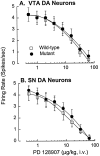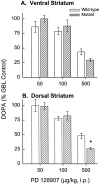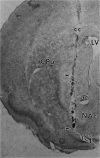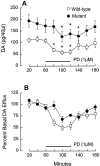Alterations in dopamine release but not dopamine autoreceptor function in dopamine D3 receptor mutant mice
- PMID: 9482807
- PMCID: PMC6792939
- DOI: 10.1523/JNEUROSCI.18-06-02231.1998
Alterations in dopamine release but not dopamine autoreceptor function in dopamine D3 receptor mutant mice
Abstract
Dopamine (DA) autoreceptors expressed along the somatodendritic extent of midbrain DA neurons modulate impulse activity, whereas those expressed at DA nerve terminals regulate both DA synthesis and release. Considerable evidence has indicated that these DA autoreceptors are of the D2 subtype of DA receptors. However, many pharmacological studies have suggested an autoreceptor role for the DA D3 receptor. This possibility was tested with mice lacking the D3 receptor as a result of gene targeting. The basal firing rates of DA neurons within both the substantia nigra and ventral tegmental area were not different in D3 receptor mutant and wild-type mice. The putative D3 receptor-selective agonist R(+)-trans-3,4,4a, 10b-tetrahydro-4-propyl-2H,5H-(1)benzopyrano(4,3-b)-1,4-oxazin+ ++-9-ol (PD 128907) was equipotent at inhibiting the activity of both populations of midbrain DA neurons in the two groups of mice. In the gamma-butyrolactone (GBL) model of DA autoreceptor function, mutant and wild-type mice were identical with respect to striatal DA synthesis and its suppression by PD 128907. In vivo microdialysis studies of DA release in ventral striatum revealed higher basal levels of extracellular DA in mutant mice but similar inhibitory effects of PD 128907 in mutant and wild-type mice. These results suggest that the effects of PD 128907 on dopamine cell function reflect stimulation of D2 as opposed to D3 receptors. Although D3 receptors do not seem to be significantly involved in DA autoreceptor function, they may participate in postsynaptically activated short-loop feedback modulation of DA release.
Figures






Similar articles
-
Synthesis and pharmacological evaluation of thiopyran analogues of the dopamine D3 receptor-selective agonist (4aR,10bR)-(+)-trans-3,4,4a,10b-tetrahydro-4-n-propyl-2H,5H [1]b enzopyrano[4,3-b]-1,4-oxazin-9-ol (PD 128907).J Med Chem. 2000 Jul 27;43(15):2871-82. doi: 10.1021/jm0000113. J Med Chem. 2000. PMID: 10956195
-
Neurochemical and functional characterization of the preferentially selective dopamine D3 agonist PD 128907.J Pharmacol Exp Ther. 1995 Dec;275(3):1355-66. J Pharmacol Exp Ther. 1995. PMID: 8531103
-
Antagonism of the effects of (+)-PD 128907 on midbrain dopamine neurones in rat brain slices by a selective D2 receptor antagonist L-741,626.Br J Pharmacol. 1996 Dec;119(7):1491-7. doi: 10.1111/j.1476-5381.1996.tb16063.x. Br J Pharmacol. 1996. PMID: 8968560 Free PMC article.
-
Dopamine D2 autoreceptor interactome: Targeting the receptor complex as a strategy for treatment of substance use disorder.Pharmacol Ther. 2020 Sep;213:107583. doi: 10.1016/j.pharmthera.2020.107583. Epub 2020 May 27. Pharmacol Ther. 2020. PMID: 32473160 Free PMC article. Review.
-
The role of D2-autoreceptors in regulating dopamine neuron activity and transmission.Neuroscience. 2014 Dec 12;282:13-22. doi: 10.1016/j.neuroscience.2014.01.025. Epub 2014 Jan 23. Neuroscience. 2014. PMID: 24463000 Free PMC article. Review.
Cited by
-
Unveiling the Differences in Signaling and Regulatory Mechanisms between Dopamine D2 and D3 Receptors and Their Impact on Behavioral Sensitization.Int J Mol Sci. 2023 Apr 4;24(7):6742. doi: 10.3390/ijms24076742. Int J Mol Sci. 2023. PMID: 37047716 Free PMC article. Review.
-
Selective D2 and D3 receptor antagonists oppositely modulate cocaine responses in mice via distinct postsynaptic mechanisms in nucleus accumbens.Neuropsychopharmacology. 2019 Jul;44(8):1445-1455. doi: 10.1038/s41386-019-0371-2. Epub 2019 Mar 16. Neuropsychopharmacology. 2019. PMID: 30879021 Free PMC article.
-
Imaging brain regional and cortical laminar effects of selective D3 agonists and antagonists.Psychopharmacology (Berl). 2010 Sep;212(1):59-72. doi: 10.1007/s00213-010-1924-6. Epub 2010 Jul 14. Psychopharmacology (Berl). 2010. PMID: 20628733 Free PMC article.
-
Dopamine D3 Receptor Availability Is Associated with Inflexible Decision Making.J Neurosci. 2016 Jun 22;36(25):6732-41. doi: 10.1523/JNEUROSCI.3253-15.2016. J Neurosci. 2016. PMID: 27335404 Free PMC article.
-
Stimulation-evoked dopamine release in the nucleus accumbens following cocaine administration in rats perinatally exposed to polychlorinated biphenyls.Toxicol Sci. 2013 Nov;136(1):144-53. doi: 10.1093/toxsci/kft171. Epub 2013 Aug 2. Toxicol Sci. 2013. PMID: 23912914 Free PMC article.
References
-
- Aghajanian GK, Bunney BS. Dopamine “autoreceptors”: pharmacological characterization by microiontophoretic single unit recording studies. Naunyn Schmiedebergs Arch Pharmacol. 1977;297:1–7. - PubMed
-
- Ahlenius S, Salmi P. Behavioral and biochemical effects of the dopamine D3 receptor-selective ligand, 7-OH-DPAT, in the normal and the reserpine-treated rat. Eur J Pharmacol. 1994;260:177–181. - PubMed
-
- Aretha CW, Sinha A, Galloway MP. Dopamine D3-preferring ligands act at synthesis modulating autoreceptors. J Pharmacol Exp Ther. 1995;274:609–613. - PubMed
-
- Bouthenet M-L, Souil E, Martres M-P, Sokoloff P, Giros B, Schwartz J-C. Localization of dopamine D3 receptor mRNA in the rat brain using in situ hybridization histochemistry: comparison with dopamine D2 receptor mRNA. Brain Res. 1991;564:203–219. - PubMed
Publication types
MeSH terms
Substances
Grants and funding
LinkOut - more resources
Full Text Sources
Molecular Biology Databases
